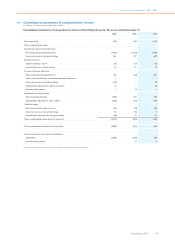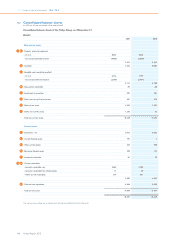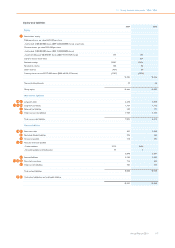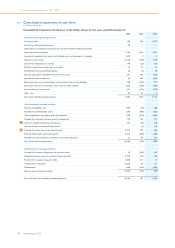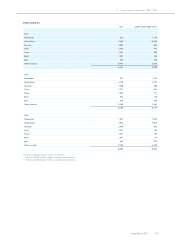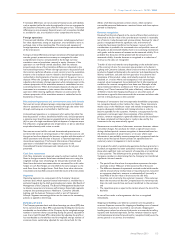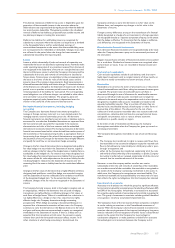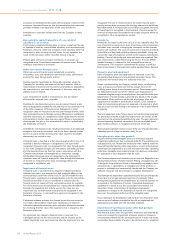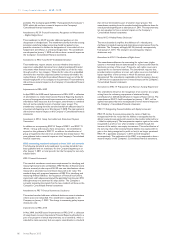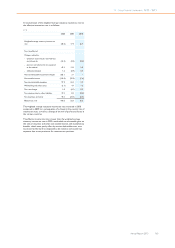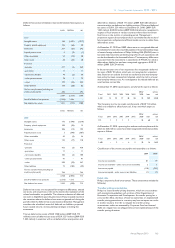Philips 2010 Annual Report Download - page 155
Download and view the complete annual report
Please find page 155 of the 2010 Philips annual report below. You can navigate through the pages in the report by either clicking on the pages listed below, or by using the keyword search tool below to find specific information within the annual report.
13 Group financial statements 13.10 - 13.10
Annual Report 2010 155
Translation differences on non-monetary financial assets and liabilities
such as equities held at fair value through profit or loss are recognized in
the Statement of income as part of the fair value gain or loss. Translation
differences on non-monetary financial assets, such as equities classified
as available for sale, are included in other comprehensive income.
Foreign operations
The assets and liabilities of foreign operations, including goodwill and
fair value adjustments arising on acquisition, are translated to euro at
exchange rates at the reporting date. The income and expenses of
foreign operations, are translated to euro at exchange rates at the dates
of the transactions.
Foreign currency differences arising on translation of foreign operations
into the group’s presentation currency are recognized in other
comprehensive income, and presented in the foreign currency
translation reserve (translation reserve) in equity. However, if the
operation is a non-wholly owned subsidiary, then the relevant
proportionate share of the translation difference is allocated to the
non-controlling interests. When a foreign operation is disposed of such
that control, significant influence or joint control is lost, the cumulative
amount is the translation reserve related to the foreign operation is
reclassified to the Statements of income as part of the gain or loss on
disposal. When the Company disposes of only part of its interest in a
subsidiary that includes a foreign operation while retaining control, the
relevant proportion of the cumulative amount is reattributed to non-
controlling interests. When the Company disposes of only part of its
investment in an associate or joint venture that includes a foreign
operation while retaining significant influence or joint control, the
relevant proportion of the cumulative amount is reclassified to the
Statements of income.
Discontinued operations and non-current assets held for sale
Non-current assets (disposal groups comprising assets and liabilities)
that are expected to be recovered primarily through sale rather than
through continuing use are classified as held for sale.
A discontinued operation is a component of an entity that either has
been disposed of, or that is classified as held for sale, and (a) represents
a separate major line of business or geographical area of operations; and
(b) is a part of a single coordinated plan to dispose of a separate major
line of business or geographical area of operations; or (c) is a subsidiary
acquired exclusively with a view to resale.
Non-current assets held for sale and discontinued operations are
carried at the lower of carrying amount or fair value less costs to sell.
Any gain or loss from disposal of a business, together with the results of
these operations until the date of disposal, is reported separately as
discontinued operations. The financial information of discontinued
operations is excluded from the respective captions in the
Consolidated financial statements and related notes for all years
presented.
Cash flow statements
Cash flow statements are prepared using the indirect method. Cash
flows in foreign currencies have been translated into euros using the
weighted average rates of exchange for the periods involved. Cash
flows from derivative instruments that are accounted for as fair value
hedges or cash flow hedges are classified in the same category as the
cash flows from the hedged items. Cash flows from other derivative
instruments are classified consistent with the nature of the instrument.
Segments
Operating segments are components of the Company’s business
activities about which separate financial information is available that is
evaluated regularly by the chief operating decision maker (the Board of
Management of the Company). The Board of Management decides how
to allocate resources and assesses performance. Reportable segments
comprise the operating sectors: Healthcare, Consumer Lifestyle,
Lighting, and the business Television which is part of Consumer
Lifestyle. Segment accounting policies are the same as the accounting
policies as applied to the Group.
Earnings per share
The Company presents basic and diluted earnings per share (EPS) data
for its common shares. Basic EPS is calculated by dividing the net income
attributable to shareholders of the Company by the weighted average
number of common shares outstanding during the period, adjusted for
own shares held. Diluted EPS is determined by adjusting the profit or
loss attributable to shareholders and the weighted average number of
common shares outstanding, adjusted for own shares held, for the
effects of all dilutive potential common shares, which comprise
convertible personnel debentures, restricted shares and share options
granted to employees.
Revenue recognition
Revenue from the sale of goods in the course of the ordinary activities is
measured at the fair value of the consideration received or receivable,
net of returns, trade discounts and volume rebates. Revenue for sale of
goods is recognized when the significant risks and rewards of
ownership have been transferred to the buyer, recovery of the
consideration is probable, the associated costs and possible return of
the goods can be estimated reliably, there is no continuing involvement
with goods, and the amount of revenue can be measured reliably. If it is
probable that discounts will be granted and the amount can be
measured reliably, then the discount is recognized as a reduction of
revenue as the sales are recognized.
Transfer of risks and rewards varies depending on the individual terms
of the contract of sale. For consumer-type products in the Sectors
Lighting and Consumer Lifestyle, these criteria are met at the time the
product is shipped and delivered to the customer and, depending on the
delivery conditions, title and risk have passed to the customer and
acceptance of the product, when contractually required, has been
obtained, or, in cases where such acceptance is not contractually
required, when management has established that all aforementioned
conditions for revenue recognition have been met. Examples of the
above-mentioned delivery conditions are ‘Free on Board point of
delivery’ and ‘Costs, Insurance Paid point of delivery’, where the point
of delivery may be the shipping warehouse or any other point of
destination as agreed in the contract with the customer and where title
and risk in the goods pass to the customer.
Revenues of transactions that have separately identifiable components
are recognized based on their relative fair values. These transactions
mainly occur in the Healthcare sector and include arrangements that
require subsequent installation and training activities in order to
become operable for the customer. However, since payment for the
equipment is contingent upon the completion of the installation
process, revenue recognition is generally deferred until the installation
has been completed and the product is ready to be used by the
customer in the way contractually agreed.
Revenues are recorded net of sales taxes, customer discounts, rebates
and similar charges. For products for which a right of return exists
during a defined period, revenue recognition is determined based on
the historical pattern of actual returns, or in cases where such
information is not available, revenue recognition is postponed until the
return period has lapsed. Return policies are typically based on
customary return arrangements in local markets.
For products for which a residual value guarantee has been granted or a
buy-back arrangement has been concluded, revenue recognition takes
place when significant risks and rewards of ownership are transferred
to the customer. The following are the principal factors that the
Company considers in determining that the Company has transferred
significant risks and rewards:
• The period from the sale to the repurchase represents the major
(normally at least 75%) part of the economic life of the asset;
• The difference between the proceeds received on the initial transfer
and the amount of any residual value or repurchase price, measured
on a present value basis, amounts to substantially all (normally at
least 90%) of the fair value of the asset at the sale date;
• Insurance risk is borne by the customer; however, if the customer
bears the insurance risk but the Company bears the remaining risks,
then risks and rewards have not been transferred to the customer;
and
• The repurchase price is equal to the market value at the time of the
buy-back.
In case of loss under a sales agreement, the loss is recognized
immediately.
Shipping and handling costs billed to customers are recognized as
revenues. Expenses incurred for shipping and handling costs of internal
movements of goods are recorded as cost of sales. Shipping and
handling costs related to sales to third parties are recorded as selling
expenses and disclosed separately. Service revenue related to repair
and maintenance activities for goods sold is recognized ratably over the
service period or as services are rendered.


